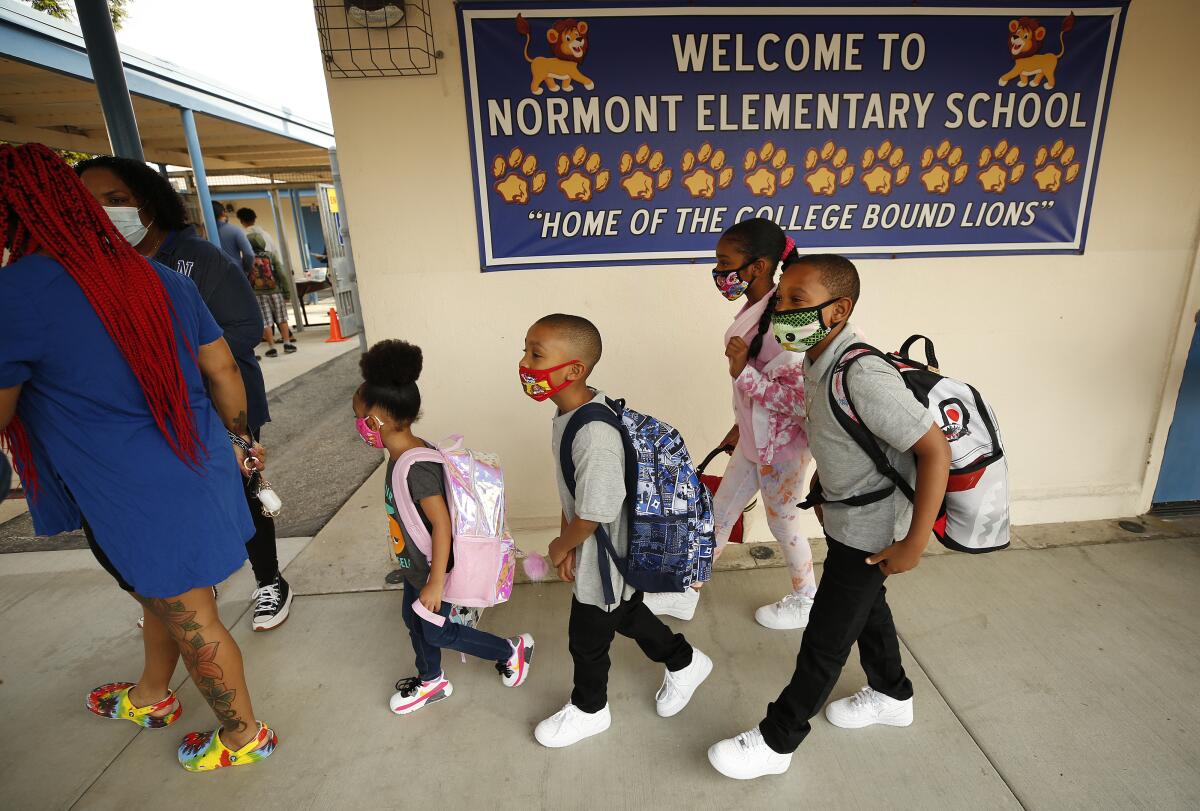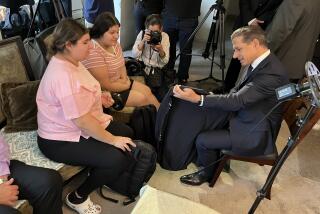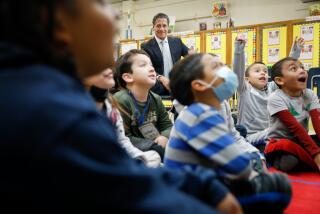How parents can keep their kids safe from COVID as they return to school

With students back in school as the Delta variant rages, parents are wondering what they can do to keep their children safe.
Early data shows a relatively small percentage of students have tested positive for coronavirus since L.A. schools began. But it will take more time to see if those trends hold up.
Still, it’s been an anxious time as school struggle with new safety protocols.
Here is a breakdown of where we are:
What does the early data from the LAUSD show?
Coronavirus cases resulted in 6,500 students missing one or more days during the first week of school, data shows. Some key points:
- About 3,000 students were in isolation because they tested positive for an infection either during the first week or in the days before the Aug. 16 start of classes. An additional 3,500 were in quarantine after they were identified as close contacts of those who tested positive.
- About 451,000 preschool through 12th-grade students are attending Los Angeles public schools in person this fall. More than 10,000 others are attending classes online through an independent study option.
- Among some 60,000 employees tested, about 1,000 missed at least one day of work during the first week of classes because of an infection or because they were in close contact with an infected person.
- As of Tuesday night, L.A. Unified officials have reported seven cases that were possibly transmitted from one person to another while on a campus since the start of school. The district also listed 2,304 total “active” infections.
What are the basic safety protocols at schools?
Federal, state and local officials stress the importance of vaccination for all eligible individuals and masking in classrooms and school buildings as the most effective methods to prevent in-school transmission of the coronavirus.
Here are the basics you should expect to see at school:
- California has mandated masks for all K-12 students when indoors with a few exceptions, which are intended to be rare and not based simply on parent and student preference or discomfort. The Los Angeles Unified School District also requires masking outdoors.
- California teachers and school staff must be vaccinated or submit to weekly coronavirus testing. Some districts, including L.A. Unified and the Santa Monica-Malibu Unified School District have enacted vaccine mandates for employees.
- Although neither the state nor the CDC require physical distancing, schools are urged to keep students distanced as much as possible. When masks are not being used, such as when students are eating or drinking, physical distancing becomes more important, even essential, in the view of some experts.
- Recommendations also call on schools to optimize ventilation in indoor spaces. Ideally, this means your school has installed high-grade MERV-13 filters on HVAC systems, although not all HVAC units can work effectively with these filters. Portable air purifiers also are being used in some cases. Even just opening one or more windows helps with ventilation.
- Facilities are supposed to be cleaned frequently.
- Increased hand-washing is expected.
- There should be limited or no sharing of school supplies.
These “layers” of safety, as officials call the measures, go a long way toward making schools safe, experts say.
Where’s the best place to look for specific information about individual schools?
School districts around California have the authority to set their own policies for their own schools, provided state and local health department requirements are met. This means your school district could have rules that are stricter than the state’s. All school districts are required by the state to post detailed safety plans on their websites, which is where you can find information specific to your school district and campus. Every school district in California was required to submit its plan to the state.
What is the state mask mandate? How is it enforced?
The state requires masking indoors; however, mask enforcement on campus is left to schools. The California Department of Public Health’s mask rules for schools are as follows:
- Masks are optional outdoors.
- K-12 students are required to mask indoors (with exemptions for children younger than 2 or those who have a medical condition).
- Exempted individuals are expected to wear a nonrestrictive alternative such as a face shield with a drape on the bottom edge.
Local educators are enacting a range of consequences for students who don’t follow the rules — such as issuing warnings or even barring them from campus. A few have suggested they may not enforce the order because they don’t believe it’s needed. Students, for the most part, appear not to be fazed by the rule and have said that they mainly are glad to be back at school with their friends.
L.A. Unified has a stricter policy than the state and is requiring students and staff to wear masks indoors and outdoors. Children older than 2 are required to have a mask on at all times while on school property, except while eating or drinking.
Because masks have to be removed, eating and drinking should take place outside whenever possible, with social distancing.
Should kids wear N95 masks?
That’s not necessary. Disposable surgical masks or cloth masks with at least two layers are fine, experts say.
“The best mask is one the child will keep on,” said Dr. Sara Bode, a pediatrician who directs school health services at Nationwide Children’s Hospital in Columbus, Ohio, and helped write the American Academy of Pediatrics’ COVID-19 guidance for schools.
It might make sense for students to pack more than one mask because masks can get dirty or soiled. One untimely sneeze could do it. Keep in mind that masks come in many forms. Some children find the ear loops uncomfortable and prefer tie-on masks. Rubber frames can be inserted to make breathing more comfortable.
Also, schools are supposed to have extra masks available, even on school buses. If they don’t, parents should speak up.
Should parents sanitize book bags and other items when kids come home from school?
No. “At first, it looked like a virus that would spread on surfaces,” said Dr. Paul Offit, director of the Vaccine Education Center at Children’s Hospital of Philadelphia. “But now we know that it is primarily transmitted through respiratory droplets.”
What about indoor activities like choir and band? Should parents discourage kids from participating?
No. But the most important way to keep things safe is for such activities to take place outside, with physical distancing. Schools figured out safe ways to offer these activities last year, and can do so again this year, the pediatrician Bode said. In these situations, it’s important that schools create layers of risk protection, she said.
Special masks for singers fit tightly around the face but bow out to leave more room for children to project their voices, she said. Likewise, there are masks with openings for band members’ mouths and also covers to catch droplets that might escape from the open ends of instruments.
What else should we be looking at?
- Good ventilation matters
“Ventilation is critically important because it is clear that the virus is spread through respiratory droplets, even through ordinary activities such as talking and eating,” said Mercedes Carnethon, an epidemiologist at Northwestern University Feinberg School of Medicine. The virus can also travel via tiny particles called aerosols that can remain suspended in the air for minutes to hours, the Centers for Disease Control and Prevention says.
This means schools should use all the tools at their disposal — opening windows and updating the filters in the HVAC system — to refresh the air. The Environmental Protection Agency says that air filters rated MERV-13 or higher can help in removing viruses from the air. It’s not a one-time deal: Filters will need to be changed out regularly.
Whenever possible, higher-risk activities such as eating, singing or playing wind instruments should take place outside, experts said.
- School transparency is key
Schools should make every effort to keep parents in the loop about the health of those on campus.
- Hold parents accountable — but offer support
Carnethon pointed to another possible weak link in protocols: Other parents, some of whom may not always be forthcoming about their children’s potential exposure — or even their own positive coronavirus test.
“This isn’t the common cold, and we have to be far more responsible about pulling kids out when they have any suspicion of COVID-19,” she said.
She pointed to a recent case in Reno, where a parent knowingly sent their child to school after they both tested positive — exposing more than 80 other students to the virus.
“So what is in place as an alternative strategy for when parents are honest about their child’s symptoms, so that they won’t be encouraged to lie?” Carnethon said. “Because that’s where things really fall apart.”
One way to help parents would be to make testing for young students available on campus, she said, because in some places it isn’t always easy to find for young children.
More to Read
Start your day right
Sign up for Essential California for news, features and recommendations from the L.A. Times and beyond in your inbox six days a week.
You may occasionally receive promotional content from the Los Angeles Times.










